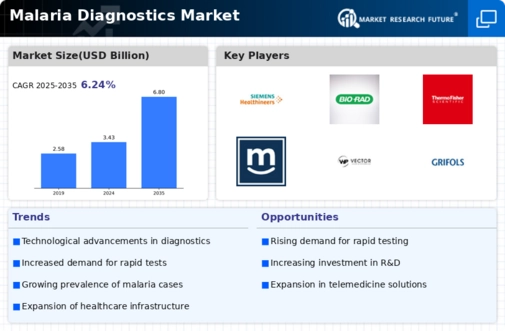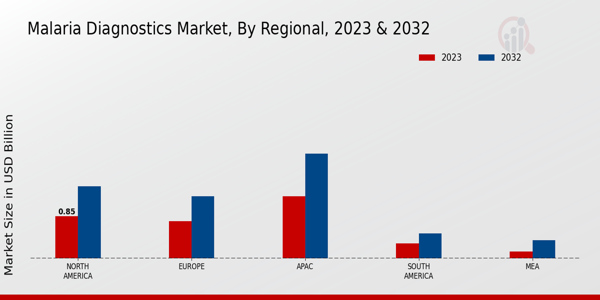Market Growth Projections
The Global Malaria Diagnostics Market Industry is projected to experience substantial growth, with estimates indicating a market value of 3.43 USD Billion in 2024 and a potential increase to 6.8 USD Billion by 2035. This growth trajectory suggests a compound annual growth rate (CAGR) of 6.42% from 2025 to 2035. Such projections reflect the increasing demand for effective malaria diagnostics driven by rising incidence rates, technological advancements, and enhanced government initiatives. The market's expansion is indicative of a global commitment to combating malaria and improving health outcomes in affected regions.
Rising Incidence of Malaria
The increasing incidence of malaria globally is a primary driver of the Global Malaria Diagnostics Market Industry. According to the World Health Organization, there were an estimated 241 million cases of malaria in 2020, with a significant burden in sub-Saharan Africa. This persistent prevalence necessitates the development and deployment of effective diagnostic tools. As the number of cases rises, the demand for rapid and accurate diagnostic solutions is expected to grow, contributing to the market's projected value of 3.43 USD Billion in 2024. The urgency to combat malaria is likely to propel innovations in diagnostic technologies.
Increased Awareness and Education
Increased awareness and education regarding malaria prevention and treatment are vital drivers of the Global Malaria Diagnostics Market Industry. Public health campaigns and educational programs have significantly improved understanding of malaria transmission and the importance of early diagnosis. Organizations such as the World Health Organization actively promote awareness initiatives, which lead to higher demand for diagnostic tests. As communities become more informed, the likelihood of seeking timely diagnosis and treatment increases, thereby stimulating market growth. This heightened awareness is expected to contribute to the overall expansion of the malaria diagnostics market.
Government Initiatives and Funding
Government initiatives and funding play a crucial role in shaping the Global Malaria Diagnostics Market Industry. Various countries are increasing their investments in malaria control programs, which include enhancing diagnostic capabilities. For example, the Global Fund and the President's Malaria Initiative have allocated substantial resources to improve malaria diagnostics in endemic regions. These efforts aim to strengthen healthcare infrastructure and ensure the availability of diagnostic tools. As governments prioritize malaria elimination, the demand for effective diagnostics is likely to rise, further driving market growth and innovation.
Emerging Markets and Population Growth
Emerging markets and population growth are influencing the Global Malaria Diagnostics Market Industry. Regions such as Southeast Asia and Africa are experiencing rapid population increases, leading to higher malaria transmission rates. As urbanization progresses, the risk of malaria outbreaks escalates, necessitating improved diagnostic solutions. The growing population in these regions is likely to drive demand for malaria diagnostics, as more individuals require testing and treatment. This trend underscores the need for scalable and accessible diagnostic tools, further propelling market growth in the coming years.
Technological Advancements in Diagnostics
Technological advancements in diagnostic tools are transforming the Global Malaria Diagnostics Market Industry. Innovations such as rapid diagnostic tests (RDTs) and polymerase chain reaction (PCR) techniques enhance the speed and accuracy of malaria detection. For instance, RDTs can provide results within 15 minutes, facilitating timely treatment. The integration of digital technologies, such as mobile health applications, further supports the monitoring and management of malaria cases. These advancements are expected to drive market growth, with projections indicating a market value of 6.8 USD Billion by 2035, reflecting a compound annual growth rate (CAGR) of 6.42% from 2025 to 2035.



















